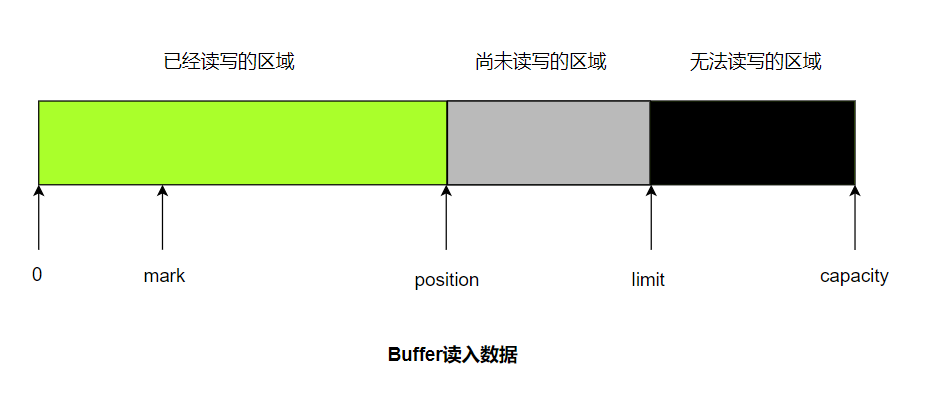NIO是啥?
NIO是Java从JDK1.4开始引入的一系列改进版输入输出处理手段,也就是New IO,简称NIO,也有说法叫NonBlocking IO,是同步非阻塞式的IO模型,准确地说它支持阻塞非阻塞两种模式。
笔者在NIO、BIO、AIO、同步异步、阻塞非阻塞傻傻分不清楚?一文中详细总结了同步、非阻塞等相关概念,分析了NIO与传统BIO的主要区别。
本篇主要介绍NIO提供的三大组件的概念及使用:Buffer,Channel,Selector。
Buffer
Buffer可以理解为是一个容器,用于存储数据,本质是个数组,存储的元素类型是基本类型。
无论是发送还是读取Channel中的数据,都必须先置入Buffer。
java.nio.Buffer是一个抽象类,子类包括有除boolean外其他所有基本类型的XxBuffer,最常用的是ByteBuffer。
Buffer中的重要概念
capacity:缓冲区的容量,表示该Buffer的最大数据容量,即最多可以存储多少数据。
limit:限制位,标记position能够到达的最大位置,默认为缓冲区最后一位。
position:操作位,指向即将操作位置,默认指向0。
mark:可选标记位。默认不启用,Buffer允许直接将position定位到mark处。
他们满足的关系:mark <= position <= limit <= capacity

以ByteBuffer.allocate(capacity)为例,说明几个重要的过程:
- 初始化创建HeapByteBuffer,mark = -1,position = 0,limit = cap。
- 通过put方法向Buffer中加入数据,position++。
- 装入数据结束后,调用flip方法,将limit设置为position所在位置,position置为0,表示[position,limit]这段需要开始进行输出了【可以使用get方法读取数据】。
- 输出结束后,调用clear方法,将position置为0,limit置为cap,为下一次读取数据做好准备。
Buffer的所有子类都提供了put和get方法,对应向Buffer存入数据和从Buffe中取出数据,方式分为以下两种:
- 相对:从Buffer的当前pos处开始读取或写入数据,然后将pos的值按处理元素的个数增加。
- 绝对:直接根据索引向Buffer中读取或写入数据,不会影响pos位置本身的值。
Buffer使用Demo
public static void main(String[] args) {
// 创建 bytebuffer allocate指定底层数组长度
ByteBuffer byteBuffer = ByteBuffer.allocate(10);
// 添加数据
byteBuffer.put("summerday".getBytes());
// 获取操作位的位置pos = 9
System.out.println(byteBuffer.position());
// 如果我想遍历summerday呢?哪里结束? limit = 10
System.out.println(byteBuffer.limit());
//反转缓冲区 可以利用flip()代替下面两步操作
//将limit移到position的位置
byteBuffer.limit(byteBuffer.position());
//将pos移到0
byteBuffer.position(0);
// position < limit
// 可以利用 hasRemaining代替判断pos和limit之间是否还有可处理元素。
while(byteBuffer.position() < byteBuffer.limit()){
// 获取数据
byte b = byteBuffer.get();
System.out.println(b);
}
}
常用方法介绍
其实Buffer操作的逻辑比较简单,每个方法操作的字段也不外乎上面介绍的几个,下面是一些常用的方法:
设置方法
- Buffer position(newPosition): 将pos设置为newPosition。
- Buffer limit(newLimit):将limit设置为newLimit。
数据操作
- Buffer reset:将pos置为mark的位置。
- Buffer rewind:将pos置为0,取消设置的mark。
- Buffer flip: 将limit置pos位置,pos置0。
- Buffer clear:将position置为0,limit置为cap。
其他操作
public static void main(String[] args) {
// 如果数据已知,可以使用wrap方法创建ByteBuffer
ByteBuffer byteBuffer = ByteBuffer.wrap("summerday".getBytes());
// 获取底层字节数组
byte[] array = byteBuffer.array();
System.out.println(new String(array));
}
Channel
Channel概述
Channel 类似于传统的流对象,但有些不同:
- Channel 直接将指定文件的部分或全部直接映射 Buffer。
- 程序不能直接访 Channel 中的数据,包括读取、写入都不行,Channel只能与 Buffer 进行交互。意思是,程序要读数据时需要先通过Buffer从Channel中获取数据,然后从Buffer中读取数据。
- Channel通常可以异步读写,但默认是阻塞的,需要手动设置为非阻塞。
Channel不应该通过构造器来直接创建,而是通过传统的节点InputStream、OutputStream的getChannel()方法来返回对应的Channel,或者通过RandomAccessFile对象的getChannel方法。
Channel中最常用的三种方法:
- map():将Channel对应的部分或全部数据映射成ByteBuffer。
- read():从Buffer中读取数据。
- write():向Buffer中写入数据。
RandomAccessFile#getChannel
下面是个简单的示例,通过RandomAccessFile的getChannel方法:
public static void main(String[] args) throws FileNotFoundException {
RandomAccessFile file = new RandomAccessFile("D://b.txt", "rw");
// 获取RandomAccessFile对应的channel
try (FileChannel fileChannel = file.getChannel()) {
ByteBuffer buf = ByteBuffer.allocate(48);
int byteRead = fileChannel.read(buf);
while(byteRead != -1){
System.out.println("read " + byteRead);
buf.flip();
while (buf.hasRemaining()){
System.out.println((char) buf.get());
}
buf.clear();
byteRead = fileChannel.read(buf);
}
} catch (IOException e) {
e.printStackTrace();
}
}
SocketChannel与ServerSocketChannel
Java为Channel接口根据不同功能,提供了不同的实现类,比如我们下面的示例:支持TCP网络通信的SocketChannel和ServerSocketChannel。
public class Client {
public static void main(String[] args) throws IOException {
// 开启客户端的channel
SocketChannel sc = SocketChannel.open();
// 手动设置为非阻塞模式
sc.configureBlocking(false);
// 发起连接
sc.connect(new InetSocketAddress(8081));
// 手动判断保证连接的建立
while(!sc.isConnected()){
// 如果多次连接都没有脸上,会认为此次连接无法建立
sc.finishConnect();
}
// 发送数据
sc.write(ByteBuffer.wrap("hello , i am client".getBytes()));
// 关闭通道
sc.close();
}
}
public class Server {
public static void main(String[] args) throws IOException {
// 开启服务器端的通道
ServerSocketChannel ssc = ServerSocketChannel.open();
// 监听端口号
ssc.bind(new InetSocketAddress(8081));
// 手动设置为非阻塞模式
ssc.configureBlocking(false);
// 接收连接
SocketChannel sc = ssc.accept();
// 保证连接
while (sc == null) {
sc = ssc.accept();
}
// 读取数据
ByteBuffer buffer = ByteBuffer.allocate(1024);
sc.read(buffer);
byte[] bs = buffer.array();
System.out.println(new String(bs, 0, buffer.position()));
// 关流
ssc.close();
}
}
Selector
NIO实现非阻塞IO的其中关键组件之一就是Selector多路复用选择器,可以注册多个Channel到一个Selector中。Selector可以不断执行select操作,判断这些注册的Channel是否有已就绪的IO事件,如可读,可写,网络连接已完成等。
一个线程通过使用一个Selector管理多个Channel。
public class Server {
public static void main(String[] args) throws IOException {
// 开启服务端的通道
ServerSocketChannel ssc = ServerSocketChannel.open();
// 设置非阻塞
ssc.configureBlocking(false);
// 绑定端口
ssc.bind(new InetSocketAddress(8081));
// 开启选择器
Selector selector = Selector.open();
// 将通道注册到选择器上
ssc.register(selector, SelectionKey.OP_ACCEPT);
while (true) {
// 选择已注册的通道
selector.select();
// 获取选择通道的事件
Set<SelectionKey> keys = selector.selectedKeys();
Iterator<SelectionKey> iterator = keys.iterator();
while (iterator.hasNext()) {
SelectionKey key = iterator.next();
// 接收
if (key.isAcceptable()) {
// 从事件中获取通道
ServerSocketChannel channel = (ServerSocketChannel) key.channel();
// 接收连接
SocketChannel sc = channel.accept();
// 设置非阻塞
sc.configureBlocking(false);
// 注册读 + 写事件
sc.register(selector, SelectionKey.OP_READ | SelectionKey.OP_WRITE);
}
// 读
if (key.isReadable()) {
// 获取通道
SocketChannel sc = (SocketChannel) key.channel();
// 读取数据到buffer
ByteBuffer buffer = ByteBuffer.allocate(1024);
sc.read(buffer);
// 反转缓冲区
buffer.flip();
System.out.println(new String(buffer.array(), 0, buffer.limit()));
// 在同一通道上注册,将会将之前注册的事件给注册
// 注销read事件
sc.register(selector, key.interestOps() ^ SelectionKey.OP_READ);
}
// 写
if (key.isWritable()) {
// 获取通道
SocketChannel sc = (SocketChannel) key.channel();
sc.write(ByteBuffer.wrap("hello client, i am server!".getBytes()));
// 注销write事件
sc.register(selector, key.interestOps() ^ SelectionKey.OP_WRITE);
}
}
iterator.remove();
}
}
}
public class Client {
public static void main(String[] args) throws IOException {
SocketChannel sc = SocketChannel.open();
sc.connect(new InetSocketAddress(8081));
sc.write(ByteBuffer.wrap("hello ! i am client !".getBytes()));
ByteBuffer buffer = ByteBuffer.allocate(1024);
sc.read(buffer);
System.out.println(new String(buffer.array(), 0, buffer.position()));
}
}